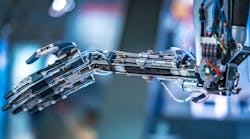Professor Lonny Simonian of the California Polytechnic State University spoke to NECA Live attendees Wednesday afternoon about the increasing use of robotics in construction. His 40-minute-long virtual session, titled, “Robots in Construction: Current Use and Outlook for the Future,” presented key research and findings from an ELECTRI International research project on the same topic. More specifically, Simonian discussed the short- and long-term impact that robots could have on the electrical industry.
“The focus of the research is to inform electrical contractors about the developments in robots in construction and to prepare you for their potential future deployment,” said Simonian. “They are in use currently, but reports show they are going to grow by a significant amount.”
Before diving into facts and figures, Simonian first clarified the term “robot,” to the audience, based on IEEE’s description.
“As defined by the IEEE, a robot is an autonomous machine capable of sensing its environment, carrying out computations to make decisions, and performing actions in the real world,” he explained.
Next, he detailed the different robot market segments, including:
- Public (defense, security/surveillance, emergency response, public safety, resource management).
- Research and Education (k-12 education, colleges/universities, vocational training, research, exploration)
- Industrial (manufacturing, construction, oil and gas, mining and quarrying, agriculture)
- Commercial (health care and quality of life, utilities, transportation, warehouse distribution, wholesale and retail)
- Consumer (toy and hobby, home health care and/quality of life, social/entertainment, personal transport).
Taking a dive into findings from the ELECTRI International research project, Simonian listed 20 types of robots appropriate to use in construction, including robotic arm, 3D printing, layout, upper-body exoskeleton, snake, materials lift, vehicle, mobile platform, and more.
Simonian then went on to discuss growth projections for robots, citing that one study predicts the construction robotics market will grow from $22.7 million in 2018 to $226.0 million annually worldwide with more than 7,000 robots performing construction work by 2025. According to another study, the global market for construction-related robotics is predicted to reach $470.61 million by the end of 2026 — a compound annual growth rate of 10.4%.
What exactly do these numbers mean for construction industry workers? Citing a third study, Simonian said that “as many as 2.7 million construction positions could be replaced by machines by 2057.”
When it comes to the electrical industry in particular, the numbers sound pretty dismal. Specifically, there is automation potential in the U.S. workforce of about 42% for electricians. Carpenters and plumbers fare worse at 50%, and operating engineers could see a staggering 88% of their jobs replaced by robots.
“Keep in mind that 2057 is a long way off,” Simonian concluded. “In the immediate future, jobs will not be replaced by automation but rather supplemented by it. Drones capturing BIM information and data are a good example of this, as are autonomous robots performing laser scanning.”



